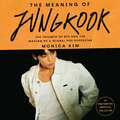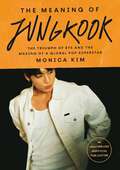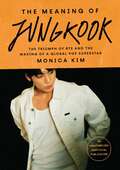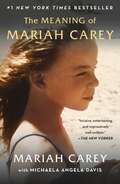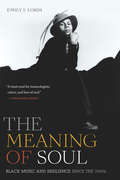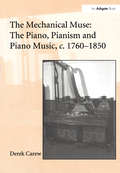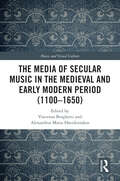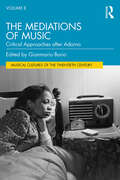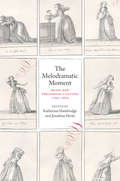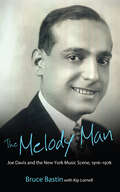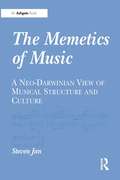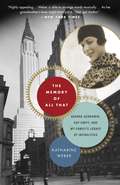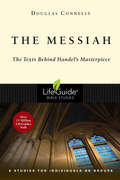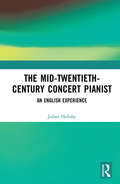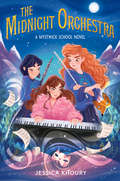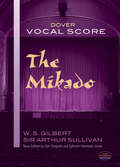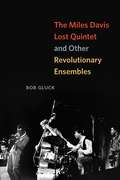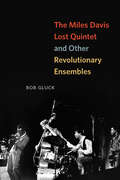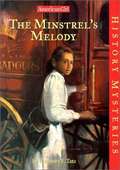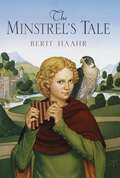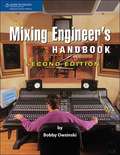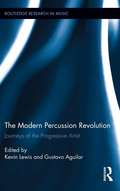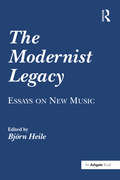- Table View
- List View
The Meaning of Jungkook: The Triumph of BTS and The Making of a Global Superstar
by Monica KimJungkook is one of the world's biggest stars, period. His first album, Golden, sold more than 2 million copies on the day of its release and stayed on the Billboard 200 for twenty-four consecutive weeks. How did a young prodigy from South Korea make music history?The Meaning of Jungkook is an unofficial kaleidoscopic exploration of the forces that made Jungkook into the triumph he is today. This book does more than just chronicle his humble beginnings in Busan and meteoric rise to fame. A lively narrative, it places Jungkook in a larger cultural and historical context, shedding light on the inner workings of the K-pop industry, internet culture, ARMY, and more. We learn that Jungkook's ruthless work ethic is a symptom of Korean culture and its singular pursuit for excellence; his style of dance places him in the lineage of Michael Jackson; and "the soldout king" has a unique visual appeal that meets high, intensive Korean beauty standards but also subverts it with his irreverent style choices.Jungkook's success is not an accident. Talent and training, the livestreams and good looks, globalization and timing all contributed to the making of Jungkook, "the Golden Maknae," the South Korean pop superstar who overcame the odds, and through his success, changed the status quo. This is an unauthorized elevated tribute to the singer, for both his fans and others interested in the genre.Monica Kim has delivered a tour-de-force, filled with vivid detail, that makes sense of the world of a music icon who has captured the devotion of millions of fans worldwide.
The Meaning of Jungkook: The Triumph of BTS and The Making of a Global Superstar
by Monica KimJungkook is one of the world's biggest stars, period. His first album, Golden, sold more than 2 million copies on the day of its release and stayed on the Billboard 200 for twenty-four consecutive weeks. How did a young prodigy from South Korea make music history?The Meaning of Jungkook is an unofficial kaleidoscopic exploration of the forces that made Jungkook into the triumph he is today. This book does more than just chronicle his humble beginnings in Busan and meteoric rise to fame. A lively narrative, it places Jungkook in a larger cultural and historical context, shedding light on the inner workings of the K-pop industry, internet culture, ARMY, and more. We learn that Jungkook's ruthless work ethic is a symptom of Korean culture and its singular pursuit for excellence; his style of dance places him in the lineage of Michael Jackson; and "the soldout king" has a unique visual appeal that meets high, intensive Korean beauty standards but also subverts it with his irreverent style choices.Jungkook's success is not an accident. Talent and training, the livestreams and good looks, globalization and timing all contributed to the making of Jungkook, "the Golden Maknae," the South Korean pop superstar who overcame the odds, and through his success, changed the status quo. This is an unauthorized elevated tribute to the singer, for both his fans and others interested in the genre.Monica Kim has delivered a tour-de-force, filled with vivid detail, that makes sense of the world of a music icon who has captured the devotion of millions of fans worldwide.
The Meaning of Jungkook: The Triumph of BTS and the Making of a Global Pop Superstar
by Monica KimCelebrate Jungkook, the once-in-a-generation talent at the center of BTS, in this illuminating look into the forces that have made him a global icon.Jungkook is one of the world&’s biggest stars, period. His first album, Golden, sold more than 2 million copies on the day of its release and stayed on the Billboard 200 for twenty-four consecutive weeks. How did a young prodigy from South Korea make music history? The Meaning of Jungkook is an unofficial kaleidoscopic exploration of the forces that made Jungkook into the triumph he is today. The book does more than chronicle his humble beginnings in Busan and meteoric rise to fame. A lively narrative, it places Jungkook in a larger cultural and historical context, shedding light on the inner workings of the K-pop industry, internet culture, ARMY, and more. We learn that Jungkook&’s ruthless work ethic is a symptom of Korean culture and its singular pursuit for excellence; his style of dance places him in the lineage of Michael Jackson; and &“the soldout king&” has a unique visual appeal that meets high Korean beauty standards but also subverts it with his irreverent piercings and tattoos. Jungkook&’s success is not an accident. Talent and training, the livestreams and good looks, globalization and timing all contributed to the making of Jungkook, &“the Golden Maknae,&” the South Korean pop superstar who overcame the odds, and through his success, changed the status quo. This is an unauthorized elevated tribute to the singer, for both his fans and others interested in the genre. Monica Kim has delivered a tour-de-force, filled with vivid detail, that makes sense of the world of a music icon who has captured the devotion of millions of fans worldwide.
The Meaning of Mariah Carey
by Mariah CareyThe global icon, award-winning singer, songwriter, producer, actress, mother, daughter, sister, storyteller, and artist finally tells the unfiltered story of her life in The Meaning of Mariah Carey <P><P>It took me a lifetime to have the courage and the clarity to write my memoir. I want to tell the story of the moments - the ups and downs, the triumphs and traumas, the debacles and the dreams, that contributed to the person I am today. Though there have been countless stories about me throughout my career and very public personal life, it’s been impossible to communicate the complexities and depths of my experience in any single magazine article or a ten-minute television interview. And even then, my words were filtered through someone else’s lens, largely satisfying someone else’s assignment to define me. <P><P>This book is composed of my memories, my mishaps, my struggles, my survival and my songs. Unfiltered. I went deep into my childhood and gave the scared little girl inside of me a big voice. I let the abandoned and ambitious adolescent have her say, and the betrayed and triumphant woman I became tell her side. <P><P>Writing this memoir was incredibly hard, humbling and healing. My sincere hope is that you are moved to a new understanding, not only about me, but also about the resilience of the human spirit. <P><P>Love,Mariah <P><P><b>A New York Times Bestseller</b>
The Meaning of Soul: Black Music and Resilience since the 1960s (Refiguring American Music)
by Emily J. LordiIn The Meaning of Soul, Emily J. Lordi proposes a new understanding of this famously elusive concept. In the 1960s, Lordi argues, soul came to signify a cultural belief in black resilience, which was enacted through musical practices—inventive cover versions, falsetto vocals, ad-libs, and false endings. Through these soul techniques, artists such as Aretha Franklin, Donny Hathaway, Nina Simone, Marvin Gaye, Isaac Hayes, and Minnie Riperton performed virtuosic survivorship and thus helped to galvanize black communities in an era of peril and promise. Their soul legacies were later reanimated by such stars as Prince, Solange Knowles, and Flying Lotus. Breaking with prior understandings of soul as a vague masculinist political formation tethered to the Black Power movement, Lordi offers a vision of soul that foregrounds the intricacies of musical craft, the complex personal and social meanings of the music, the dynamic movement of soul across time, and the leading role played by black women in this musical-intellectual tradition.
The Mechanical Muse: The Piano, Pianism and Piano Music, c.1760-1850
by Derek CarewThis book charts the piano's accession from musical curiosity to cultural icon, examining the instrument itself in its various guises as well as the music written for it. Both the piano and piano music were very much the product of the intellectual, cultural and social environments of the period and both were subject to many influences, directly and indirectly. These included character (individualism), the vernacular ('folk/popular') and creativity (improvisation), all of which are discussed generally and with respect to the music itself. Derek Carew surveys the most important pianistic genres of the period (variations, rondos, and so on), showing how these changed from their received forms into vehicles of Romantic expressiveness. The piano is also looked at in its role as an accompanying instrument. The Mechanical Muse will be of interest to anyone who loves the piano or the period, from the non-specialist to the music postgraduate.
The Media Swirl: Politics, Audiovisuality, and Aesthetics
by Carol VernallisFrom fan-generated content on TikTok to music videos, the contemporary media landscape is becoming ever more vast, spectacular, and intense. In The Media Swirl Carol Vernallis examines short-form audiovisual media—Beyoncé’s Lemonade, brief sequences from Baz Luhrmann’s The Great Gatsby, TikTok challenges, YouTube mashups, commercials, and many other examples—to offer ways of understanding digital media. She analyzes music videos by Beyoncé, Lady Gaga, Janelle Monáe, Kendrick Lamar, Anderson .Paak, and others to outline how sound and image enhance each other and shape a viewer’s mood. Responding to today’s political-media landscape through discussions of Fox News and Presidential inaugurations, Vernallis shows how a media literacy that exceeds newscasts and campaign advertising is central to engaging with the democratic commons. Forays into industry studies, neuroscience, and ethics also inform her readings. By creating our own content and knowing what corporations, the wealthy, and the government do through media, Vernallis contends, we can create a more just world.
The Media of Secular Music in the Medieval and Early Modern Period (Music and Visual Culture)
by Vincenzo Borghetti and Alexandros Maria HatzikiriakosThis book brings a new perspective to secular music sources from the Middle Ages and early modernity by viewing them as media communication tools, whose particular features shape the meaning of their contents. Ranging from the eleventh to seventeenth centuries, and across countries and genres, the chapters offer innovative insights into the historical relationship between music and its presentation in a wide variety of media.The lens of media enables contributors to expand music history beyond notated music manuscripts and instruments to include images, furniture, luxury items, and other objects, and to address uniquely visual and material aspects of music sources in books and literature. Drawing together an international group of contributors, the volume pays close attention to the medial and material dimensions of musical sources, considering them as multifaceted objects that not only contain but also determine the nature of the music they transmit.Transforming our understanding of musical media, this volume will be of interest to scholars of musicology, art history, and medieval and early modern cultures.
The Mediations of Music: Critical Approaches after Adorno (Musical Cultures of the Twentieth Century)
by Gianmario BorioAdorno believed that a circular relationship was established between immediacy and mediation. Should we now say that this model with its clear Hegelian influence is outdated? Or does it need some theoretical integration? This volume addresses these questions by covering the performance of music, its technological reproduction and its modes of communication – in particular, pedagogy and dissemination through the media. Each of the book’s four parts deal with different aspects of the mediation process. The contributing authors outline the problematic moments in Adorno’s reasoning but also highlight its potential. In many chapters the pole of immediacy is explicitly brought into play, its different manifestations often proving to be fundamental for the understanding of mediation processes. The prime reference sources are Adorno’s Current of Music, Towards a Theory of Musical Reproduction and Composing for the Films. Critical readings of these texts are supplemented by reflections on performance studies, media theories, sociology of listening, post-structuralism and other contiguous research fields.
The Melodramatic Moment: Music and Theatrical Culture, 1790–1820
by Jonathan Hicks Katherine HambridgeWe seem to see melodrama everywhere we look—from the soliloquies of devastation in a Dickens novel to the abject monstrosity of Frankenstein’s creation, and from Louise Brooks’s exaggerated acting in Pandora’s Box to the vicissitudes endlessly reshaping the life of a brooding Don Draper. This anthology proposes to address the sometimes bewilderingly broad understandings of melodrama by insisting on the historical specificity of its genesis on the stage in late-eighteenth-century Europe. Melodrama emerged during this time in the metropolitan centers of London, Paris, Vienna, and Berlin through stage adaptations of classical subjects and gothic novels, and they became famous for their use of passionate expression and spectacular scenery. Yet, as contributors to this volume emphasize, early melodramas also placed sound at center stage, through their distinctive—and often disconcerting—alternations between speech and music. This book draws out the melo of melodrama, showing the crucial dimensions of sound and music for a genre that permeates our dramatic, literary, and cinematic sensibilities today. A richly interdisciplinary anthology, The Melodramatic Moment will open up new dialogues between musicology and literary and theater studies.
The Melody Man: Joe Davis and the New York Music Scene, 1916-1978 (American Made Music Series)
by Bruce BastinJoe Davis (1896–1978), the focus of The Melody Man, enjoyed a fifty-year career in the music industry, which covered nearly every aspect of the business. He hustled sheet music in the 1920s; copyrighted compositions by artists as diverse as Fats Waller, Carson Robison, Otis Blackwell, and Rudy Vallee; oversaw hundreds of recording sessions; and operated several record companies beginning in the 1940s. Davis also worked fearlessly to help ensure that black recording artists and song writers gained equal treatment for their work.Much more than a biography, this book is an investigation of the role played by music publishers during much of the twentieth century. Joe Davis was not a music “great,” but he was one of those individuals who enabled “greats” to emerge. A musician, manager, and publisher, his long career reveals much about the nature of the music industry and offers insight into how the industry changed from the 1920s to the 1970s. By the summer of 1924, when Davis was handling the “race talent” for Ajax records, he had already worked in the music business for most of a decade, and there were more than five decades of musical career ahead of him. The fact that his fascinating life has gone so long underappreciated is remedied by the publication of this book.Originally published in England in 1990 as Never Sell a Copyright: Joe Davis and His Role in the New York Music Scene, 1916–1978, this book was never released in the United States and only made available in a very limited print run in England. The author, noted blues scholar and folklorist Bruce Bastin, has worked with fellow music scholar Kip Lornell to completely update, condense, and improve the book for this first-ever American edition.
The Memetics of Music: A Neo-Darwinian View of Musical Structure and Culture
by Steven JanRichard Dawkins's formulation of the meme concept in his 1976 classic The Selfish Gene has inspired three decades of work in what many see as the burgeoning science of memetics. Its underpinning theory proposes that human culture is composed of a multitude of particulate units, memes, which are analogous to the genes of biological transmission. These cultural replicators are transmitted by imitation between members of a community and are subject to mutational-evolutionary pressures over time. Despite Dawkins and several others using music in their exemplifications of what might constitute a meme, these formulations have generally been quite rudimentary, even na. This study is the first musicologically-orientated attempt systematically to apply the theory of memetics to music. In contrast to the two points of view normally adopted in music theory and analysis - namely those of the listener and the composer - the purpose of this book is to argue for a distinct and illuminating third perspective. This point of view is metaphorical and anthropomorphic, and the metaphor is challenging and controversial, but the way of thinking adopted has its basis in well-founded scientific principles and it is capable of generating insights not available from the first two standpoints. The perspective is that of the (selfish) replicated musical pattern itself, and adopting it is central to memetics. The approach taken is both theoretical and analytical. Starting with a discussion of evolutionary thinking within musicology, Jan goes on to cover the theoretical aspects of the memetics of music, ranging from quite abstract philosophical speculation to detailed consideration of what actually constitutes a meme in music. In doing so, Jan draws upon several approaches current in music theory, including Schenkerism and Narmour's implication-realization model. To demonstrate the practical utility of the memetic perspective, Chapter 6 applies it analytically, tracing the transmission o
The Memory of All That: "George Gershwin, Kay Swift, and My Family's Legacy of Infidelities
by Katharine WeberThe Memory of All That is Katharine Weber's memoir of her extraordinary family. Her maternal grandmother, Kay Swift, was known both for her own music (she was the first woman to compose the score to a hit Broadway show, Fine and Dandy) and for her ten-year romance with George Gershwin. Their love affair began during Swift's marriage to James Paul Warburg, the multitalented banker and economist who advised (and feuded with) FDR. Weber creates an intriguing and intimate group portrait of the renowned Warburg family, from her great-great-uncle, the eccentric art historian Aby Warburg, whose madness inspired modern theories of iconography, to her great-grandfather Paul M. Warburg, the architect of the Federal Reserve System whose unheeded warnings about the stock-market crash of 1929 made him "the Cassandra of Wall Street." Her mother, Andrea Swift Warburg, married Sidney Kaufman, but their unlikely union, Weber believes, was a direct consequence of George Gershwin's looming presence in the Warburg family. A notorious womanizer, Weber's father was a peripatetic filmmaker who made propaganda and training films for the OSS during World War II before producing the first movie with smells, the regrettable flop that was AromaRama. He was as much an enigma to his daughter as he was to the FBI, which had him under surveillance for more than forty years, and even noted Katharine's birth in a memo to J. Edgar Hoover.Colorful, evocative, insightful, and very funny, The Memory of All That is an enthralling look at a tremendously influential--and highly eccentric--family, as well as a consideration of how their stories, with their myriad layers of truth and fiction, have both provoked and influenced one of our most prodigiously gifted writers.
The Messiah: The Texts Behind Handel's Masterpiece (LifeGuide Bible Studies)
by Douglas ConnellyProphets prophesied about him. Angels and shepherds rejoiced at his birth. Friends cried for joy at his resurrection. And we still celebrate him today. He is Jesus, the Messiah. Perfect for Advent or Lent, this eight-session LifeGuide Bible Study guide explores some of the key passages in the Old Testament about the Messiah and their completion in the life and saving work of Jesus. These passages have had a profound effect on the imagination and worship of Christians for two thousand years, leading George Frederic Handel to write one of the greatest expressions of worship and adoration—his oratorio, the Messiah. We hear parts of it sung every year during the Christmas season, but what many listeners fail to realize is that the entire text of Handel's Messiah is drawn from Scripture—and many of the Old Testament passages that shaped Israel's hope for their Redeemer are included in that text. This guide leads you through Scripture passages used in Handel's work that highlight who Jesus is and what he came to do. It might change the way you listen to the Messiah. Even more, it might change the way you live. For over three decades LifeGuide Bible Studies have provided solid biblical content and raised thought-provoking questions—making for a one-of-a-kind Bible study experience for individuals and groups. This series has more than 130 titles on Old and New Testament books, character studies, and topical studies.
The Mid-Twentieth-Century Concert Pianist: An English Experience
by Julian HellabyIn this book, Julian Hellaby presents a detailed study of English piano playing and career management as it was in the middle years of the twentieth century. Making regular comparisons with early twenty-first-century practice, the author examines career-launching mechanisms, such as auditions and competitions, and investigates available means of career sustenance, including artist management, publicity outlets, recital and concerto work, broadcasts, recordings and media reviews. Additionally, Hellaby considers whether a mid-twentieth-century school of English piano playing may be identified and, if so, whether it has lasted into the early decades of the twenty-first century. The author concludes with an appraisal of the state of English pianism in recent years and raises questions about its future. Drawing on extensive research from a wide variety of primary and secondary sources, this book is structured around case-studies of six pianists who were commencing and then developing their careers between approximately 1935 and 1970. The professional lives and playing styles of Malcolm Binns, Peter Katin, Moura Lympany, Denis Matthews, Valerie Tryon and David Wilde are examined, and telling comparisons are made between the state of affairs then and that of more recent times. Engagingly written, the book is likely to appeal to professional and amateur pianists, piano teachers, undergraduate and postgraduate music students, academics and anyone with an interest in the history of pianists, piano performance and music performance history in general.
The Midnight Orchestra (A Mystwick School Novel)
by Jessica KhouryIn this spellbinding sequel to The Mystwick School of Musicraft, Amelia must master the magic of Composing to help her school win a magic competition—and save her friends from a mysterious evil.Things are finally looking up for Amelia Jones: she's officially a Mystwick student, and she even has a teacher to help her learn how to use her rare Composing magic. When Mystwick enters an international magic competition, it’s Amelia's chance to Compose something that will help them win the day.The only problem is that she still doesn’t understand how her powers work. But then she hears about a super exclusive Midnight Orchestra—half performance, half magical black market—and Amelia is sure that’s where she’ll find the answer to her Composing problem.But the Midnight Orchestra is far more sinister than it initially appears and if Amelia can’t unlock her Composing powers, not only will Mystwick lose the musicraft competition, she won’t be able to rescue her friends from the danger unleashed in this thrilling adventure.
The Mikado Vocal Score (Dover Opera Scores)
by W. S. Gilbert Sir Arthur SullivanAn enduringly popular romantic spoof that has charmed countless listeners since its 1885 debut, The Mikado's appealing Japanese setting lends fresh novelty to Sullivan's winsome melodies and Gilbert's satirical verses.This new vocal score edition by Carl Simpson and Ephraim Hammett Jones includes all the voice parts, a piano reduction of the full score, and the complete libretto. This inexpensive edition exactly matches the excellent full score of The Mikado, also published by Dover, and prepared by the same editorial team. It will be indispensable to soloists, chorus members, and rehearsal pianists.
The Miles Davis Lost Quintet and Other Revolutionary Ensembles
by Bob GluckMiles Davis's Bitches Brew is one of the most iconic albums in American music, the preeminent landmark and fertile seedbed of jazz-fusion. Fans have been fortunate in the past few years to gain access to Davis's live recordings from this time, when he was working with an ensemble that has come to be known as the Lost Quintet. In this book, jazz historian and musician Bob Gluck explores the performances of this revolutionary group--Davis's first electric band--to illuminate the thinking of one of our rarest geniuses and, by extension, the extraordinary transition in American music that he and his fellow players ushered in. Gluck listens deeply to the uneasy tension between this group's driving rhythmic groove and the sonic and structural openness, surprise, and experimentation they were always pushing toward. There he hears--and outlines--a fascinating web of musical interconnection that brings Davis's funk-inflected sensibilities into conversation with the avant-garde worlds that players like Ornette Coleman and John Coltrane were developing. Going on to analyze the little-known experimental groups Circle and the Revolutionary Ensemble, Gluck traces deep resonances across a commercial gap between the celebrity Miles Davis and his less famous but profoundly innovative peers. The result is a deeply attuned look at a pivotal moment when once-disparate worlds of American music came together in explosively creative combinations.
The Miles Davis Lost Quintet and Other Revolutionary Ensembles
by Bob GluckMiles Davis’s Bitches Brew is one of the most iconic albums in American music, the preeminent landmark and fertile seedbed of jazz-fusion. Fans have been fortunate in the past few years to gain access to Davis’s live recordings from this time, when he was working with an ensemble that has come to be known as the Lost Quintet. In this book, jazz historian and musician Bob Gluck explores the performances of this revolutionary group—Davis’s first electric band—to illuminate the thinking of one of our rarest geniuses and, by extension, the extraordinary transition in American music that he and his fellow players ushered in. Gluck listens deeply to the uneasy tension between this group’s driving rhythmic groove and the sonic and structural openness, surprise, and experimentation they were always pushing toward. There he hears—and outlines—a fascinating web of musical interconnection that brings Davis’s funk-inflected sensibilities into conversation with the avant-garde worlds that players like Ornette Coleman and John Coltrane were developing. Going on to analyze the little-known experimental groups Circle and the Revolutionary Ensemble, Gluck traces deep resonances across a commercial gap between the celebrity Miles Davis and his less famous but profoundly innovative peers. The result is a deeply attuned look at a pivotal moment when once-disparate worlds of American music came together in explosively creative combinations.
The Minstrel's Melody (American Girl History Mysteries #11)
by Eleanora E. TateIn 1904, twelve-year-old Orphelia follows her dream by running away from home to join an all-black minstrel show headed for the Saint Louis World's Fair, and learns about her family's troubled past in the process.
The Minstrel's Tale
by Berit HaahrThirteen-year-old Judith of Nesscliff is a talented musician. If she had her way, she’d spend her life composing and playing. But in the England of the fourteenth century, girls can’t be musicians. Besides, Judith’s stepfather has decided it’s time she was married. It doesn’t matter that her husband is at least thirty years her senior and already has five daughters— some of them older than Judith; her stepfather thinks it’s a good match. Judith doesn’t agree. Disguised in boy’s clothing, Judith becomes Jude and runs away from home. With only a falcon for company, she sets out on a 200-mile journey, hoping to become one of the King’s Minstrels. Along the way, she is attacked by thieves and forced to fend off the advances of a young woman who thinks “Jude” would make an ideal husband. Through it all, Judith must chart a path that will allow her to live the life she longs for--and find love as well. Set against the colorful backdrop of medieval England, Berit Haahr’s first novel introduces an independent heroine who refuses to give up her dreams no matter what others expect of her. Ages 12 and up
The Mixing Engineer's Handbook (2nd edition)
by Bobby OwsinskiAppropriate for both novice and experienced recording engineers, this guide walks through the six elements of a mix--balance, panorama, frequency range, dimension, dynamics, and interest--and provides interviews with 22 professional mixers working in different genres. The second edition adds sections on gating, hypercompression, MP3 encoding, and surround sound mixing.
The Modern Composer and His World (Scholarly Reprint Series Edition)
by Udo Kasemets John BeckwithProceedings of the International Conference of Composers attended by SCEG at the Stratford Festival, Stratford, Ontario in August 1960.
The Modern Percussion Revolution: Journeys of the Progressive Artist (Routledge Research in Music)
by Kevin Lewis Gustavo AguilarMore than eighty years have passed since Edgard Varèse’s catalytic work for percussion ensemble, Ionisation, was heard in its New York premiere. A flurry of pieces for this new medium dawned soon after, challenging the established truths and preferences of the European musical tradition while setting the stage for percussion to become one of the most significant musical advances of the twentieth century. This 'revolution', as John Cage termed it, was a quintessentially modernist movement - an exploration of previously undiscovered sounds, forms, textures, and styles. However, as percussion music has progressed and become woven into the fabric of Western musical culture, several divergent paths, comprised of various traditions and a multiplicity of aesthetic sensibilities, have since emerged for the percussionist to pursue. This edited collection highlights the progressive developments that continue to investigate uncharted musical grounds. Using historical studies, philosophical insights, analyses of performance practice, and anecdotal reflections authored by some of today's most engaged performers, composers, and scholars, this book aims to illuminate the unique destinations found in the artistic journey of the modern percussionist.
The Modernist Legacy: Essays on New Music
by Björn HeileThis collection of essays offers a historical reappraisal of what musical modernism was, and what its potential for the present and future could be. It thus moves away from the binary oppositions that have beset twentieth-century music studies in the past, such as those between modernism and postmodernism, between conceptions of musical autonomy and of cultural contingency and between formalist-analytical and cultural-historical approaches. Focussing particularly on music from the 1970s to the 1990s, the volume assembles approaches from different perspectives to new music with a particular emphasis on a critical reassessment of the meaning and function of the legacy of musical modernism. The authors include scholars, musicologists and composers who combine culturally, socially, historically and aesthetically oriented approaches with analytical methods in imaginative ways.
